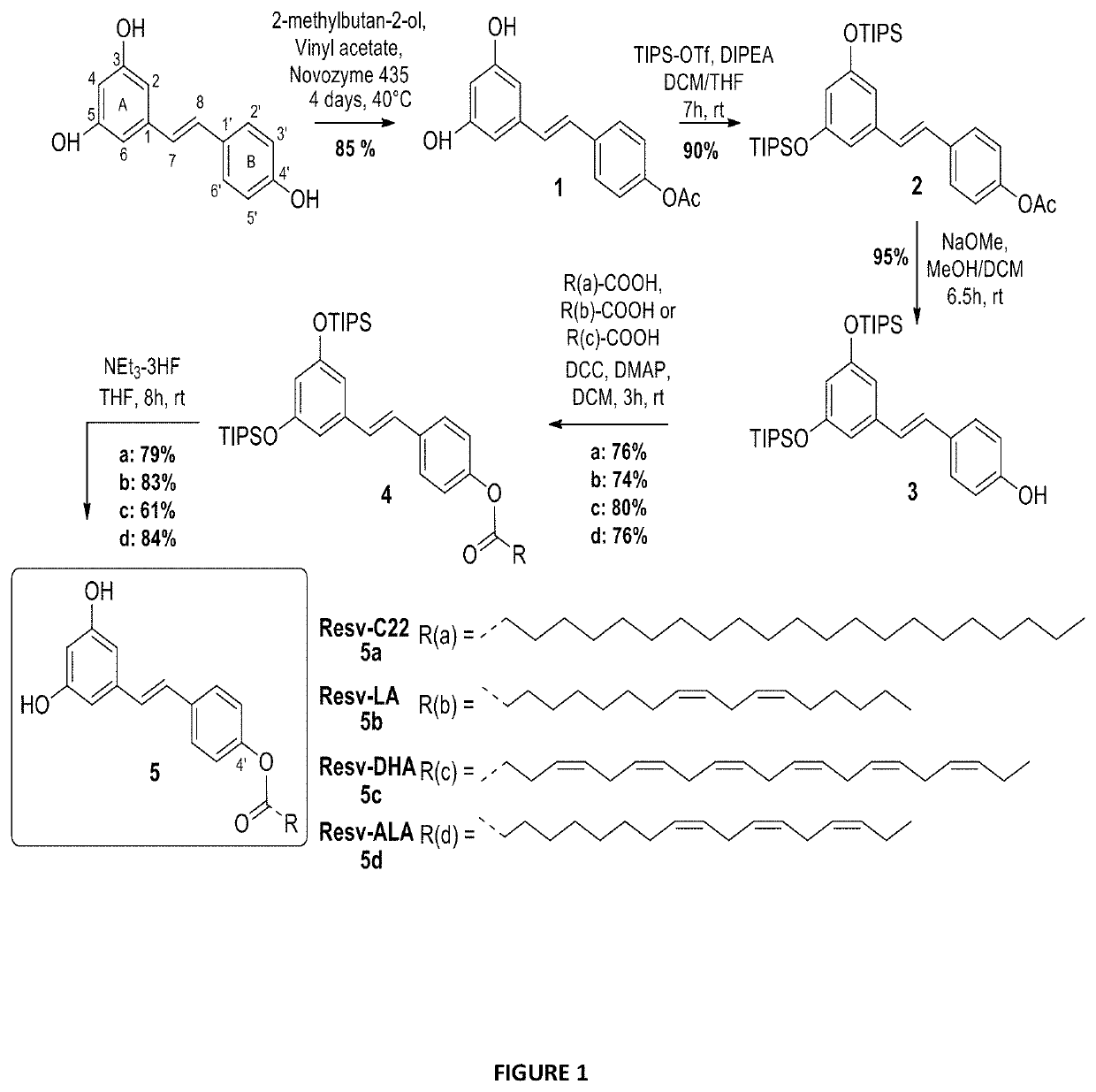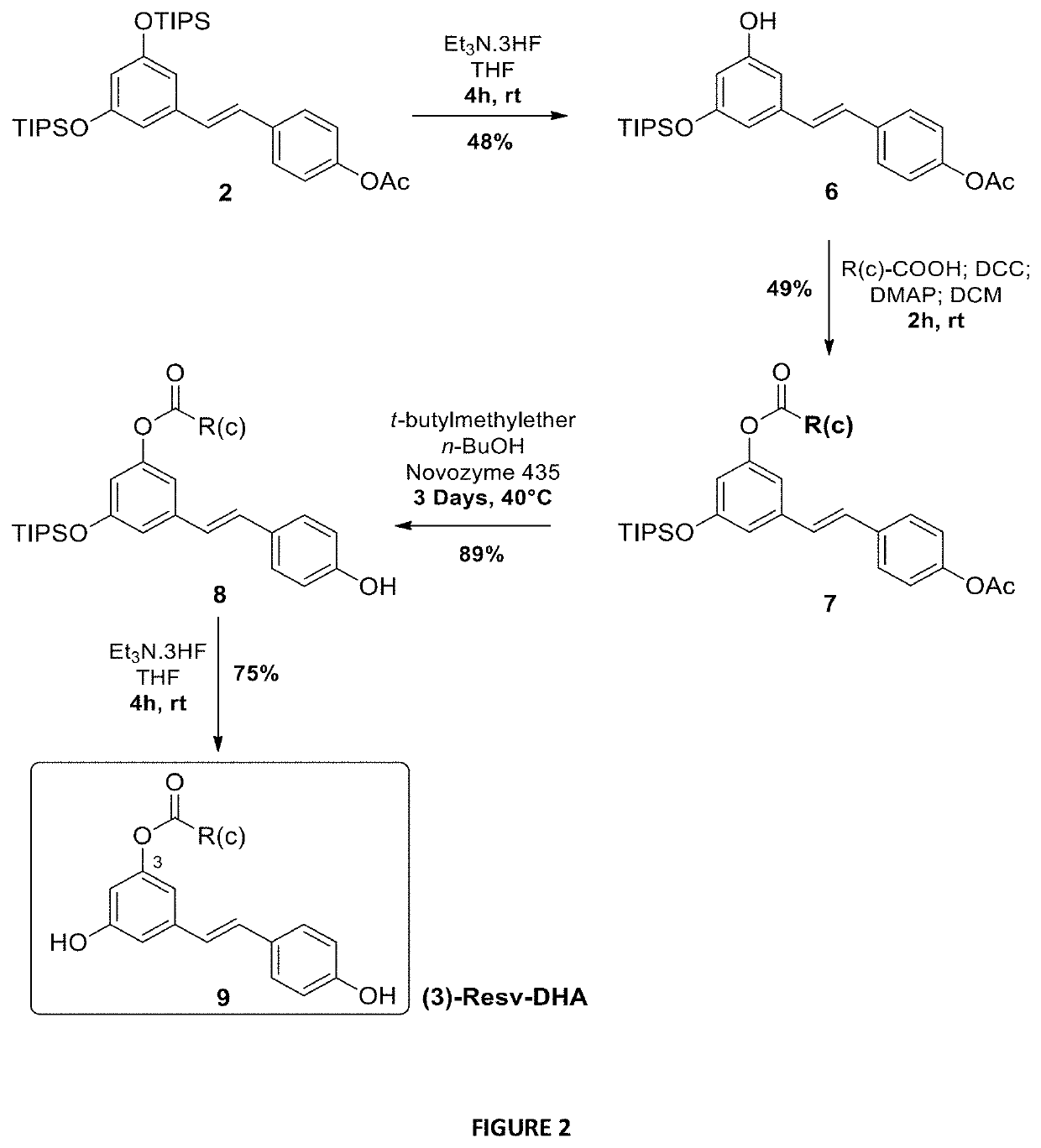Uses of lipophenolic compounds
a technology of lipophenolic compounds and phenolic compounds, which is applied in the field of lipophenolic compounds, can solve the problems that its use in in vivo treatment is still not considered
- Summary
- Abstract
- Description
- Claims
- Application Information
AI Technical Summary
Benefits of technology
Problems solved by technology
Method used
Image
Examples
example 1
of Resveratrol Derived Lipophenols
[0197]To evaluate the activity of different lipid chains at the 4′ position, Resv-C22 or Resv-BE (5a), Resv-LA (5b), Resv-DHA (5c) and Resv-ALA (5d) were synthesized using enzymatic and chemical synthesis starting from resveratrol (FIG. 1). In the first step, the supported lipase Candida antartica (CALB, Novozyme 435, selective of the 4′ position) was used to introduce acetyl group regio-selectively at the resveratrol C4OH position. The reaction was performed in good yield (85%) without any acetyl derivatives at the 3 or 5 positions. Hydroxyl groups at 3 and 5 positions of compound 1 were then protected by triisopropylsilyl (TIPS) protecting groups using triflate reagent (TIPS-OTf) and diisopropylethylamine (DIPEA) as a base to obtain the protected derivative 2. The acetyl group of compound 2 was deprotected with a solution of sodium methanolate (MeONa) in anhydrous methanol and resulted resveratrol-diTIPS (3) in an excellent yield of 95%. The coupl...
example 2
Lipophenolic Derivative of Resveratrol on MMP-9 Activity
[0227]THP-1 cells were seeded (3×105 cell / well) in 24-well plate with 10 ng / mL TNF-α with or without 30 μM of resveratrol derivatives dissolved in DMSO. After 24 hours incubation at 37° C., supernatant was collected and tested on zymography. Gel bands demonstrates MMP-9 activity of activated THP-1 cell line in presence of resveratrol lipophenolic derivatives.
Assessment of MMP-9 Activity in THP-1 Cell Line
[0228]Low-serum (1%) RPMI-1640 medium was used for the assessment of MMP-9 activity on TNF-alpha activated THP-1 cell line 3×106 cell / mL. Firstly, resveratrol and its derived lipophenolic compounds were dissolve in DMSO, and incubated at a final concentration of 30 μM with 10 ng / mL TNF-alpha treated THP-1 in CO2 incubator chamber for 24 hours at 37° C. After incubation, cell suspension was centrifuged at 1200 r.p.m for five minutes, supernatant was recovered and stored at −80° C. for zymogram analysis.
Zymogram
[0229]The anti MMP...
example 3
Lipophenolic Derivative of Resveratrol on In Vitro Vascular Permeability Assay (FITC-Dextran Endothelial Permeability Assay)
[0233]The permeability of HUVEC monolayer seeded on collagen coated semi-permeable inserts was examined using in vitro vascular permeability assay kit, Millipore™ (Paris, France) according to the manufacturer protocol.
[0234]Endothelial cells are seeded into the inserts and cultured until complete monolayer formation occurs. After forming confluent monolayer by seeding HUVECs (4×105 cells / insert) for 48 hours, medium was replaced with 100 ng / mL TNF-α in medium with and without MMP-9 inhibitors at 10 μM and incubated for 24 hours in CO2 chamber at 37° C. Lipophenolic derivatives of resveratrol were dissolved in DMSO, and SB-3CT (gelatinase inhibitor) was dissolved in DMSO.
[0235]At the end of the permeability treatment, 150 μl FITC-dextran in media solution were incubated for 20 minutes at room temperature protected from light. FITC-dextran permeates the treated c...
PUM
| Property | Measurement | Unit |
|---|---|---|
| temperature | aaaaa | aaaaa |
| reaction time | aaaaa | aaaaa |
| reaction time | aaaaa | aaaaa |
Abstract
Description
Claims
Application Information
 Login to View More
Login to View More - R&D
- Intellectual Property
- Life Sciences
- Materials
- Tech Scout
- Unparalleled Data Quality
- Higher Quality Content
- 60% Fewer Hallucinations
Browse by: Latest US Patents, China's latest patents, Technical Efficacy Thesaurus, Application Domain, Technology Topic, Popular Technical Reports.
© 2025 PatSnap. All rights reserved.Legal|Privacy policy|Modern Slavery Act Transparency Statement|Sitemap|About US| Contact US: help@patsnap.com



